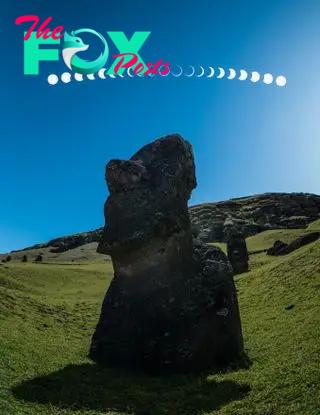Science
'Ring of fire' solar eclipse blazes over Easter Island in incredible new image

On Wednesday (Oct. 2) a ring of fire appeared in the sky over one of the most isolated islands on Earth as thousands of enormous stone heads looked on.
This was not a sign of the gods' fury (we hope) but a spectacular form of partial eclipse called an annular solar eclipse — sometimes dubbed a "ring of fire" eclipse, for the bright hoop of light that becomes visible during the eclipse's peak, when the moon blocks out roughly 90% of the sun's visible surface.
Arriving just months after the April 8 total solar eclipse that stunned millions of skywatchers across North America, Wednesday's celestial event was only visible from a small handful of inhabited places, including southern Chile and Argentina. But the most spectacular view was arguably from the Pacific island of Rapa Nui (also known as Easter Island), where U.K.-based astrophotographer Josh Dury was ready to watch the event unfold over the island's famous stone moai statues.
In an incredible composite image shared with Live Science, Dury captured the full transit of the moon across the sun's face — a slow-burning celestial event that lasted about 3.5 hours from start to finish, and a little over 6 minutes during its peak "ring of fire" phase. In the foreground, a stern moai statue points its nose skyward.
"[This is] 21 images blended into a single frame," Dury said in an email. "Captured between 12:23 - 15:52 local time."
Dury added that a personal friend and tour guide allowed him and his travel companion — Dury's mother — to access a normally restricted area of the national park called the Rano Raraku quarry, where hundreds of moai statues stand. "If it was not for him, we would not be able to get this picture," Dury said. This special tour allowed Dury and his mother to witness "the last annular eclipse over the island in 312 years," he added. "A very special moment to share indeed."
Related: Perseid meteor shower rains 'shooting stars' over Stonehenge in glorious astrophotography image
-

 Science1d ago
Science1d agoInside Capitol Hill’s Latest UFO Hearings
-

 Science1d ago
Science1d agoYou Won’t Want to Miss the Leonid Meteor Shower. Here’s How and When You Can See It
-

 Science2d ago
Science2d agoHere’s What Trump’s Win Means for NASA
-

 Science5d ago
Science5d agoWhy Risky Wildfire Zones Have Been Increasing Around the World
-

 Science6d ago
Science6d agoIt’s Time to Redefine What a Megafire Is in the Climate Change Era
-

 Science1w ago
Science1w ago4 Astronauts Return to Earth After Being Delayed by Boeing’s Capsule Trouble and Hurricane Milton
-

 Science1w ago
Science1w agoThe Elegance and Awkwardness of NASA’s New Moon Suit, Designed by Axiom and Prada
-

 Science1w ago
Science1w agoSpaceX Launches Its Mega Starship Rocket. This Time, Mechanical Arms Catch It at Landing



























